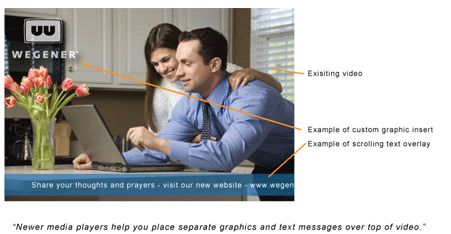File Based Broadcasting for Churches
by Gary Pelkey, WEGENER, VP – System Architect
Small screen video displays are popping up everywhere within churches – from the main auditorium to class rooms and corridors. In many cases they are replacing printed signs. Why? Cost and dynamics. 
Desktop digital video and graphic products are getting easier to use and can quickly generate compelling, professional promotional pieces.
Flat panel video displays are relatively cheap (the cost of an average 20” screen is $150). Media players, used for video playout, cost about the same as a desktop PC computer. Compare this to the price of printing a color 17” x 24” poster every week for a year ($40 x 52 = $2080) and it is easy to see the potential cost savings – even if you add in the cost of a flat screen wall mount and speakers. This fact is amplified when you consider the printing cost is a recurring yearly expense.
Utilizing digital video and digital monitors creates an opportunity for churches to refine their message from room to room and week to week. It sharpens the focus on timely, relevant messages whether they take the form of a proverb, advertising a local charity event or the re-play of a sermon.
When considering setting up a small video network of 5 or more screens here are a few important tips:
1. Scalability and Control: Invest in a solution to remotely control your media players. Your goal should be to control, schedule and monitor multiple displays from a single interface. Most media player manufacturers offer their own network control software. These offer the greatest control as they are optimized to the specific feature set of the media player. Network control software can be used to manage content distribution, content archiving, and media player video outputs (e.g. playlists, schedules, text displays and graphics).
2. Content Production: Try to limit how much video content is created with embedded one-time-use messages or logos. Newer media players help you place separate graphics and text messages over top of video. This will help you re-use existing video or images.
3. Network Maintenance: If possible use dedicated hardware to drive video playout. Trouble-shooting multiple computers, operating systems, and software programs is the last thing you want to do Sunday morning. Look for solutions that offer plug-and-play ease – where a simple power re-start does not require manually re-starting a software program at each media player/screen location.
4. Managing Bandwidth Usage: Whether you are using existing communication wiring (IP or BNC cable) or the Internet to distribute video, be mindful of bandwidth usage. Working with full-resolution HD video can be taxing not only on the communication wiring, but also on the central media servers used to store digital files and the hard-drives used by media players. Using newer video compression standards can significantly help. Consider converting old video files into MPEG-4 (h.264) video compressed files. MPEG-4 offers excellent broadcast-grade video quality while providing 20-40% bandwidth savings. It is also a widely used stable standard with no shortage of off-the-shelf products and online advice available to consumers.
A practical way to address these considerations in one swoop is creating a video network around file-based broadcasting. File-based broadcasting, or ‘store and forward’, is a method where content is created and centralized in one location and then ‘pushed’ to and stored on media players. Instructions are sent separately to remotely ‘command’ the media player to play out content in a pre-defined manner. Media players may also be continuously monitored from the central location to ensure that all of the desired content is playing out in the desired manner. Having pioneered many file-based solutions for a variety of clients WEGENER has seen its use in digital signage to dynamically combine/layer different file-based video, text and graphics elements on multiple screens simultaneously. It has also been used in video and radio applications to save bandwidth by eliminating the transmission of repetitive programming.
This method improves the distribution and output of high quality HD video to remote locations or satellite sites. It allows churches to retain control of when and where the content plays, and gain complete confidence in video file delivery. It consistently provides a more reliable outcome compared to Internet-based live video streaming, viewer-initiated video downloads or DVD mailers.
Consider giving your church an additional dynamic communication tool. Following the tips listed in this article you too can implement a small video network in a cost-effective manner.
Gary Pelkey,
WEGENER, VP – System Architect
tel: 770-814-4030,
email: g.pelkey@wegener.com




